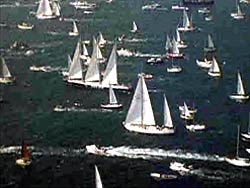Around the World |
 |
 |
 |
 |
The Ultimate Challenge
 The beginning of the ultimate boat race around the world a trip of nearly 27,000 miles (32,000nM). The race pushes both man and machine to the outer limits as they navigate some of the most hazardous sailing conditions known to man.
The beginning of the ultimate boat race around the world a trip of nearly 27,000 miles (32,000nM). The race pushes both man and machine to the outer limits as they navigate some of the most hazardous sailing conditions known to man.
The race requires a world-wide support system defining ports of call, rules, scoring systems and boat specifications. Such a race is a hugely expensive event and if it where to proceed sponsors would have to be convinced to finance the challenge.
 In 1971 such a race was discussed amongst the sailing fraternity, many believed that such a race was implausible. At that time no more than 10 yachts had rounded cape horn in one piece, to add to this a race had been attempted on this scale and had ended badly.
In 1971 such a race was discussed amongst the sailing fraternity, many believed that such a race was implausible. At that time no more than 10 yachts had rounded cape horn in one piece, to add to this a race had been attempted on this scale and had ended badly.
In 1967 'The Sunday Times' of London had the ingenuity to sponsor an event called 'The Golden Globe race', eight boats entered and only one finished. The others were forced to give up because of catastrophic equipment failures, capsized boats or they sank, one crew member took it so badly he comitted suicide.
With this kind of bad press few sponsors were willing to have their names associated with such an event. However what this race did do was to inspire other ocean sailors who wanted to step up to the round the world challenge.
The Royal Navy & Whitbread plc get involved
Sponsorship was becoming a problem for the race, to give the race new credibility it needed to attract financing from a significant high profile backer.
The Royal Navy then stepped in, they viewed the race as a way to teach teamwork and build pride within its ranks. A global race also seemed to be an effective way of getting involved with the ocean racing community. In April 1972 the Royal Navy Sailing Association announced it would support the race the following year.
As a result of this the RNSA contacted Whitbread plc. Whitbread did not just have a respected reputation in British commerce it also had the financial backing to underwrite such an ambitious race. The RNSA and Whitbread provided the race with the administritive and financial backing needed to push the event from the drawing board to the oceans.
Whitbread with it's financial underpinning and the Royal Navy providing it's spacious and secure portsmouth naval base as a pre-race staging area and starting line.
 The naval facility was perfect it could comfortably house the large expensive boats during the pre-race period while also providing military base security. In addition the military could provide the Worldwide communications network to allow racers to communicate all around the world.
The naval facility was perfect it could comfortably house the large expensive boats during the pre-race period while also providing military base security. In addition the military could provide the Worldwide communications network to allow racers to communicate all around the world.
The RNSA provided credibility and an aura of tradition. the Royal navy had a rich and well respected seafaring history and Whitbread was virtually a british institution amongst the public.
By mid 1973 the first Whitbread round the world race was ready to begin. On 8th September 17 boats carrying 167 crew members crossed the starting line in Portsmouth harbour.